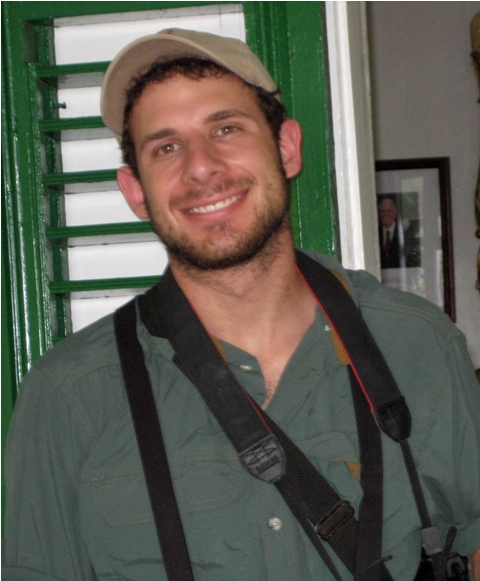
NACCB 2012 Student Talk Award Winners
Sixty students participated in the 2012 NACCB Student Talk Awards Competition. Following are the abstracts from the three award winners.
 First Place
First Place
Jessica Junker, University of Leipzig
Recent Decline In Suitable Environmental Conditions For African Apes - An Attempt To Bridge The Gap Between Local Efforts And Global Perspectives
We predict distribution of suitable environmental conditions (SEC) for African apes across 23 range countries for the 1990s and 2000s, assess the relative importance of factors influencing SEC distribution and estimate rates of SEC loss, isolation and fragmentation over time. We extracted 15051 presence localities for eight great ape subspecies from the A.P.E.S. database and related these to environmental, climate and human impact factors combining MAXENT and logistic regression models. Proportional SEC loss over time was highest for Cross River gorillas (-61%), followed by eastern (-52%), western gorillas (-32%), bonobos (-29%), central (-17%) and western chimpanzees (-11%). Nigerian-Cameroon- and eastern chimpanzees did not seem to have experienced such dramatic SEC reductions. Except for the eastern gorilla, number of SEC patches did not change significantly over time, suggesting that SEC loss mainly led to a reduction in overall patch size. This study represents the currently best available estimate of continent wide African SEC distribution and its change over the past 20 years. It is also the first attempt to amalgamate data from numerous ape sites across the continent to bridge the gap between local efforts in the field and a global perspective on ape populations. Although the model has statistical limitations that do not allow for drawing inferences at the site-specific level, it has potential for wide applicability at the regional scale, including identifying priority conservation areas, mitigation efforts for resource extraction industry, potential wildlife corridors and future survey sites. With more data, we hope to further validate and improve the current model to predict distribution and change of great ape SEC for the future and provide a global decision-making tool for the effective allocation of future conservation and funding efforts.

Second Place
Justin Kitzes, University of California, Berkeley
The Tradeoff Between Patch Size And Clustering In Designing Reserve Networks
The probability of a species persisting in a patchy landscape can generally be increased by increasing patch sizes and by reducing the distances between patches. Selecting a network of reserves in a fragmented landscape requires a tradeoff between these two goals, as the set of the largest available patches is unlikely to also be the most clustered set of patches available. Here we investigate general patterns in the species and landscapes for which minimizing inter-patch distances or maximizing mean local patch area most increases survival rates. We construct stochastic metapopulation models for 10 g to 100 kg idealized terrestrial mammal species using allometric relationships from the literature and use these models to simulate population trajectories in patchy landscapes. An analysis of two-patch networks finds that each species has a characteristic range of distances, from 0.25 to 1.25 times a species' maximum dispersal distance, within which patch clustering may increase the probability of survival. In an empirical landscape in northern California, species near 1 to 10 kg in body size have the highest survival rates in a clustered network, while larger species have the highest survival rates in a network that maximizes mean local patch area. The results demonstrate that conservation planners must use caution in choosing a level of clustering for reserve networks, as clustering may improve the resilience of some species to global change while disadvantaging others.

Third Place
Daniel Karp, Stanford University
Intensive Agriculture Erodes Beta-Diversity At Large Scales
Biodiversity is declining from land conversions of unprecedented scale, which replace diverse, low-intensity agriculture with vast expanses under homogeneous, intensive production. The most important determinant of diversity at these large scales is the degree to which local sites differ in their species compositions (beta diversity). While the consequences of land-use intensification for local (alpha) diversity are well-studied, the impacts on beta-diversity are almost entirely unknown. Using a 10-year dataset on Costa Rican birds, we find lower-intensity agricultural practices sustained beta-diversity across large scales on a par with native forest. In both forest and low-intensity agriculture, bird communities changed as vegetation structure turned over with distance. By contrast, we find that high-intensity agricultural practices homogenized vegetation structure across great distances, causing bird community turnover to decline by ~40% relative to the turnover in forest or lower-intensity agriculture. These results suggest that rapid rates of agricultural expansion and intensification threaten diversity not only locally, but also at larger spatial scales, and biotic homogenization may accelerate species loss beyond even current dire predictions. Because beta-diversity is sustained in low-intensity agriculture, however, our findings also point the way towards multi-functional agricultural systems that maintain productivity while simultaneously conserving biodiversity.